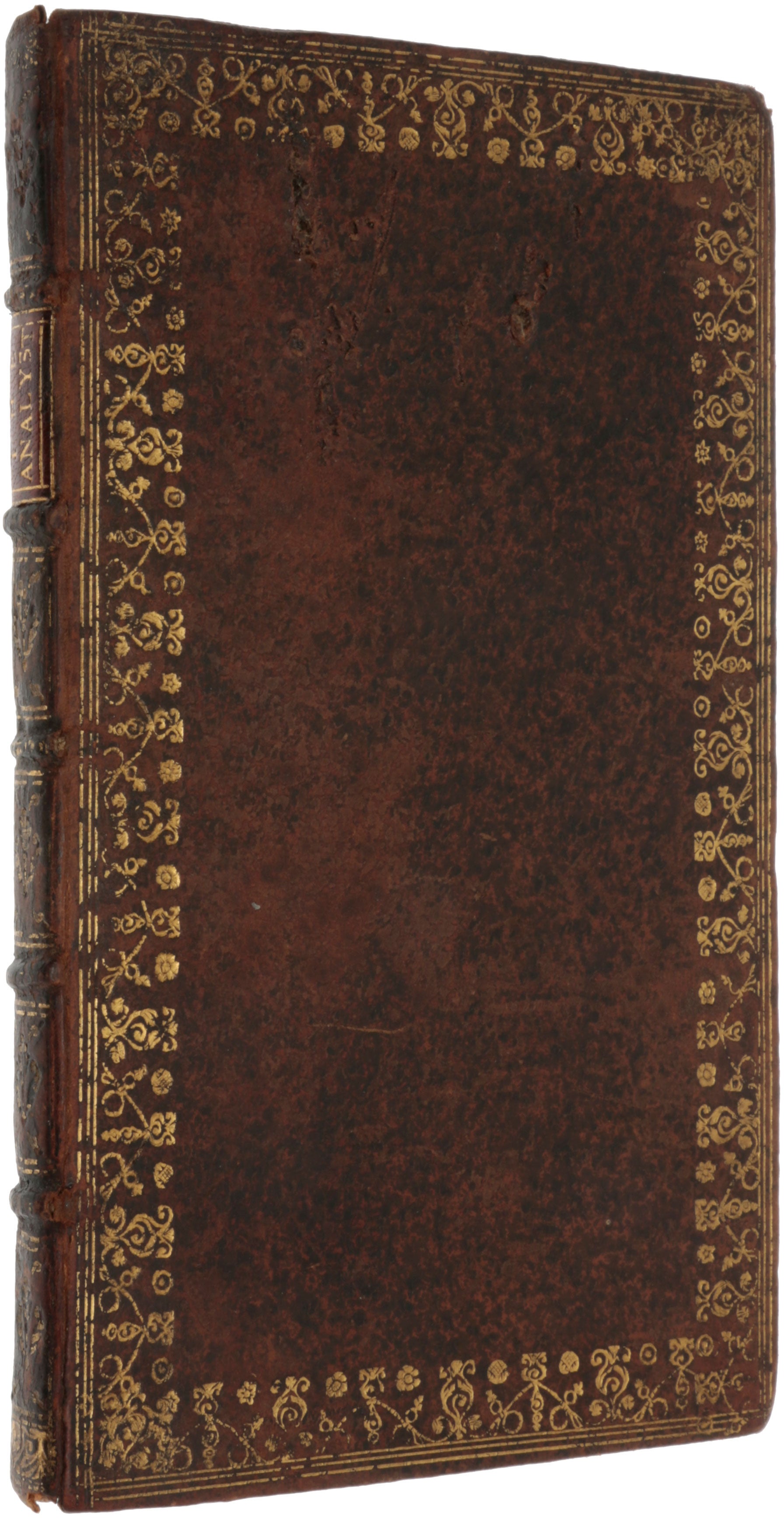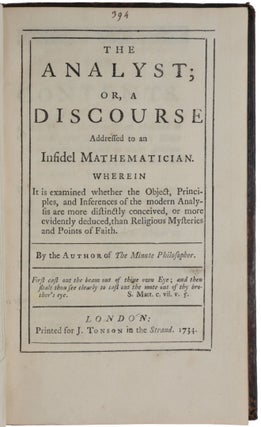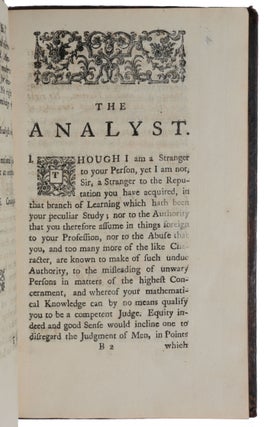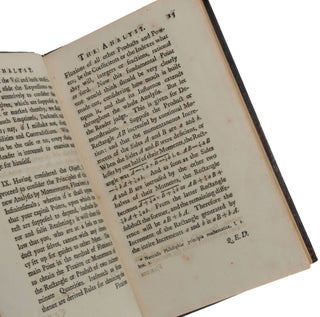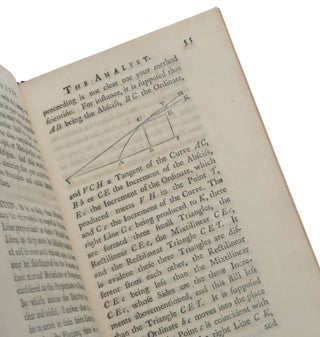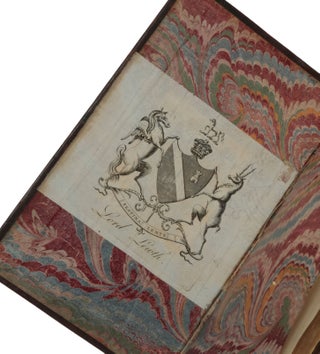The Analyst; or, a discourse addressed to an infidelmathematician. Wherein it is examined whether the object, principles, and inferences of the modern analysis are more distinctly conceived, or more evidently deduced, than religious mysteries and points of faith.
London: printed for Jacob Tonson, 1734. First edition, a spectacular copy, and one of the first issued (see below), of Berkeley’s famous attack on the calculus of Newton and Leibniz, which the historian Florian Cajori described as “the most spectacular event of the century in the history of British mathematics” (History of the Calculus, p. 57). “The Analyst is a criticism of the calculus, in both its Newtonian and Leibnizian formulations, arguing that the foundations of the calculus are incoherent and the reasoning employed inconsistent. Berkeley’s powerful objections provoked numerous responses, and the task of replying to them set the agenda for much of British mathematics in the 1730s and 1740s” (Jesseph, p. 121). Perhaps the most famous passage in the book (p. 59), and a vivid example of Berkeley’s wit, is his response to the idea that fluxions could be defined using ultimate ratios of vanishing quantities: ‘It must, indeed, be acknowledged, that [Newton] used Fluxions, like the Scaffold of a building, as things to be laid aside or got rid of, as soon as finite Lines were found proportional to them. But then these finite Exponents are found by the help of Fluxions. Whatever therefore is got by such Exponents and Proportions is to be ascribed to Fluxions: which must therefore be previously understood. And what are these Fluxions? The Velocities of evanescent Increments? And what are these same evanescent Increments? They are neither finite Quantities nor Quantities infinitely small, nor yet nothing. May we not call them the Ghosts of departed Quantities?’ Modern historians have argued that the expression ‘Ghosts of departed Quantities’ was intended to address both Leibnizian infinitesimals and Newtonian fluxions. “Berkeley’s attack on the calculus pointed out real deficiencies … his attack was also incisive, witty, and infuriating. Many mathematicians were moved to try to answer it. In fact, several important eighteenth-century discussions of the foundations of the calculus can be traced back to Berkeley’s attack. For instance, Maclaurin’s monumental two-volume A Treatise ofFluxions began as a reply to Berkeley. Berkeley’s attack had a more lasting effect than simply stimulating an immediate set of replies; it served to keep the question of foundations alive and under discussion, and it pointed to the questions which had to be answered if a successful foundation were to be given. D’Alembert and Lazare Carnot both used some of Berkeley’s arguments in their own discussions of foundations, and Lagrange took Berkeley’s criticisms with the utmost seriousness” (Grabiner, p. 27). Despite these 18th century attempts, calculus was not placed on a secure foundation until around 1820, with the work of Bolzano and Cauchy on the theory of limits. The ‘Infidel Mathematician’ in the title is thought to be Edmund Halley (1656-1742). This is a rare book on the market: only four copies have appeared at auction in the last 25 years. Provenance: Lord Louth, i.e., Matthew Plunkett, de jure 9th Baron Louth (1698-1754) (contemporary engraved armorial bookplate on front paste-down). “Most mathematicians who dealt with calculus techniques in the early 18th century did not worry overmuch about foundational questions. Indeed, it is significant that the first intensive discussion on the foundations of the calculus was not caused by difficulties encountered in working out or applying the new techniques, but by the critique of an outsider on the pretence of mathematicians that their science is based on secure foundations and therefore attains truth. The outsider was Bishop George Berkeley (1685-1753), the famous philosopher, and the target of his critique is made quite clear in the title of [the present work]. In sharp but captivating words he exposed the vagueness of infinitely small quantities, evanescent increments and their ratios, higher-order differentials and higher-order fluxions (para. 4): ‘Now as our Sense is strained and puzzled with the perception of Objects extremely minute, even so the Imagination, which Faculty derives from Sense, is very much strained and puzzled to frame clear Ideas of the least Particles of time, or the least Increments generated therein: and much more so to comprehend the Moments, or those Increments of the flowing Quantities in statu nascenti, in their very first origin or beginning to exist, before they become finite Particles. And it seems still more difficult, to conceive the abstracted Velocities of such nascent imperfect Entities. But the Velocities of the Velocities, the second, third, fourth and fifth Velocities, &c. exceed, if I mistake not, all Humane Understanding. The further the Mind analyseth and pursueth these fugitive Ideas, the more it is lost and bewildered; the Objects, at first fleeting and minute, soon vanishing out of sight. Certainly in any Sense a second or third Fluxion seems an obscure Mystery. The incipient Celerity of an incipient Celerity, the nascent Augment of a nascent Augment i.e. of a thing which hath no Magnitude: Take it in which light you please, the clear Conception of it will, if I mistake not, be found impossible, whether it be so or no I appeal to the trial of every thinking Reader. And if a second Fluxion be inconceivable, what are we to think of third, fourth, fifth Fluxions, and so onward without end?’ “Further on comes the most famous quote from The analyst: ‘And what are these Fluxions? The Velocities of evanescent Increments? And what are these same evanescent Increments?•They are neither finite Quantities, nor Quantities infinitely small nor yet nothing. May we not call them the Ghosts of departed Quantities?’ (para. 35). Berkeley also criticised the logical inconsistency of working with small increments which first are supposed unequal to zero in order to be able to divide by them, and finally are considered to be equal to zero in order to get rid of them. “Of course Berkeley knew that the calculus, notwithstanding the unclarities of its fundamental concepts, led, with great success, to correct conclusions. He explained this success – which led mathematicians to believe in the certainty of their science – by a compensation of errors, implicit in the application of the rules of the calculus. For instance, if one determines a tangent, one first supposes the characteristic triangle similar to the triangle of ordinate, sub-tangent and tangent, which involves an error because these triangles are only approximately similar. Subsequently one applies the rules of the calculus to find the ratio dy/dx, which again involves an error as the rules are derived by discarding higher-order differentials. These two errors compensate each other, and thus the mathematicians arrive ‘though not at Science, yet at Truth, For Science it cannot be called, when you proceed blind-fold, and arrive at the Truth not knowing how or by what means’ (para. 22)” (Grattan-Guinness, pp. 88-9). “Aside from calling the rigor and coherence of the Newtonian fluxional calculus into question, Berkeley argued that there was no useful distinction between it and the Leibnizian calculus differentialis. This charge had a significant ad hominem effect in the context of Newtonians’ claims for the superior rigor of their procedures in comparison with those of the Leibnizian school. After remarking that Newton’s method is ‘in effect the same with that used in the calculus differentialis’ because it requires a ‘marvellous sharpness of Discernment, to be able to distinguish between evanescent Increments and infinitesimal Differences’ (Section 17), Berkeley echoes the Newtonian complaints against Leibnizian infinitesimal differences by arguing that the Leibnizians make ‘no manner of scruple, first to supposed, and secondly to reject Quantities infinitely small: with what clearness in the Apprehension and justness in the reasoning, any thinking man, who is not prejudiced in favour of these things, may easily discern’ (Section 18). The result is that Newtonian criticisms of the Leibnizian calculus are turned against the calculus of fluxions itself, and the foundations of the calculus are rendered obscure and burdened with apparent self-contradiction” (Jesseph, p. 128). “Berkeley’s publication of The analyst took up two themes that had long been of concern to him, one mathematical and the other theological. Mathematically, it continued the reservations about the foundations of the calculus that Berkeley had voiced in an early essay ‘Of infinites’ that he presented to the Dublin Philosophical Society in 1709 and reprised in arts. 130–132 of the Principles. Theologically, The analyst was part of Berkeley’s battle against freethinking, and his principal argument intends to show that freethinkers who deride revealed religion for its mysteries cannot consistently accept the calculus, since it contains suppositions at least as extravagant and incomprehensible as anything in revealed religion. This aspect of his criticism is indicated in the full title of The analyst, which characterizes the work as A Discourse addressed to an infidel mathematician; wherein it is examined whether the object, principles, and inferences of the modern analysis are more distinctly conceived or more evidently deduced, than religious mysteries and points of faith and attributes it to ‘The Author of The minute philosopher’. “Whether the work was directed at a specific ‘infidel mathematician’ is somewhat uncertain, although there is evidence that Berkeley intended it for Edmond Halley. According to Berkeley’s 18th-century biographer Joseph Stock, the London physician Samuel Garth had declined the last rites in his final illness, on the grounds that ‘my friend Dr. Halley who has dealt so much in demonstration has assured me that the doctrines of Christianity are incomprehensible and the religion itself an imposture’. According to Stock, Berkeley ‘therefore took arms against this redoubtable dealer in demonstration, and addressed the Analyst to him, with a view of shewing, that Mysteries in Faith were unjustly objected to by mathematicians, who admitted much greater Mysteries, and even falsehoods in Science, of which he endeavoured to prove that the doctrine of fluxions furnished an eminent example’ (Stock, pp. 29–30). Whomever The analyst was intended to address immediately, its broader audience was unmistakably those mathematicians who regarded the calculus as a rigorous and properly founded method that compared favorably with the mysterious tenets of revealed religion” (Jesseph, pp. 123-4). “As a result [of the publication of The Analyst], there appeared within the next seven years some thirty pamphlets and articles which attempted to remedy the situation. The first appeared in 1734, a pamphlet by James Jurin, Geometry No Friend to Indidelity … Berkeley answered Jurin in 1735, in A Defence of Freethinking in Mathematics, and justly asserted that the latter was attempting to defend what he did not understand. In this work Berkeley again appealed to the divergence in Newton’s views – as presented in De analysi, the Principia, and De quadratura – to show a lack of clarity in the ides of moments, fluxions, and limits. Jurin’s reply in the same year, in The Minute Mathematician, was again evasively tautological … Berkeley now dropped out of the controversy, but the unsatisfactory nature of Jurin’s arguments was pointed out by Benjamin Robins in A Discourse Concerning the Nature and certainty of Sir Isaac Newton’s Methods of Fluxions and of Prime and Ultimate Ratios (1735), as well as in articles in current journals … numerous attempts, some noteworthy and others insignificant, were made to find new and more satisfactory forms and arguments in which to present Newton’s method. By far the ablest and most famous of these was made by Colin Maclaurin. In his Treatise of Fluxions, in 1742, he aimed not to alter the conceptions involved in Newton’s fluxions, but to demonstrate the validity of his method by rigorous procedures of the ancients – to deduce the new analysis from a few ‘unexceptional principles’. Maclaurin professed in the preface of this work that the Analyst controversy had given occasion to his treatise” (Boyer, p. 228-33). According to Fraser (The Works of George Berkeley III, 1871, p. 257), the first edition of The Analyst was published in March 1734. Almost all copies (including all three in Cambridge University Library) have the last two of the three instances of the word ‘Science’ in Query 36 (p. 85) corrected by hand to ‘Evidence’. That this is also the case in a presentation copy in the J. M. Keynes Collection, King’s College, Cambridge, leaves, Keynes notes, “no doubt as to Berkeley’s intention”; this correction has been made in the version printed in the Works (1784). Our copy has not been corrected, indicating that it was one of the first copies off the press, distributed before the error had been noticed. A second edition was published at Dublin later in the same year (Keynes notes that Berkeley did not leave London for Ireland until April, and that two of the three errata were corrected in the Dublin edition); it was advertised on 4 June in the Dublin Journal as “just published”. The two texts are not identical; e.g. in para. 5, “of a plain an infinitely little plain” in the London text is corrected to “of a plane an infinitely little plane” in the Dublin text (this is not noted in the errata to the first edition). Another edition was published at London in 1754. Matthew, the 9th Baron Louth, was a minor when his father Oliver died. Eighteen months later he was brought to England from Ireland and was placed under the guardianship of Matthew Aylmer, a first cousin of his grandfather, and a convert to Protestantism. Matthew, the heir to the Louth title, was a sickly child, but grew up to marry an Englishwoman, father an heir and settle in Louth Hall, County Louth. His guardian, Aylmer, saw that he was educated in the Protestant religion. Aylmer unsuccessfully petitioned Queen Anne on Matthew’s behalf seeking that the minor be restored to all the family’s honours. Matthew remained a Protestant and his descendants were members of the Church of Ireland for many generations. Barchas 167; ESTC T21863; Honeyman 287; Keynes, Bibliography of George Berkeley 138a; Richard Green 31; Sotheran I, 347; Stanitz 52A; Wallis 245.42. Boyer, The History of the Calculus and its Conceptual Development, 1949; Cajori, A History of the Conceptions of Limits and Fluxions, 1919; Grattan-Guinness, From the Calculus to Set Theory 1630-1910, 1980; Grabiner, The Origins of Cauchy’s Rigorous Calculus, 1981; Jesseph, ‘George Berkeley, The Analyst (1734),’ pp. 121-30 in Landmark Writings in Western Mathematics 1640-1940, Grattan-Guinness (ed.), 2005; Stock, An Account of the Life of George Berkeley, 1776.
8vo (198 x 118 mm), pp. [x], 94, [2, errata], title-page within a double-ruled border, woodcut diagrams in text, woodcut head- and tail-pieces and initials. Contemporary mottled calf, ornate gilt borders, spine gilt, gilt edges (upper cover with a few scratches). A superb copy.
Item #5457
Price: $48,500.00

